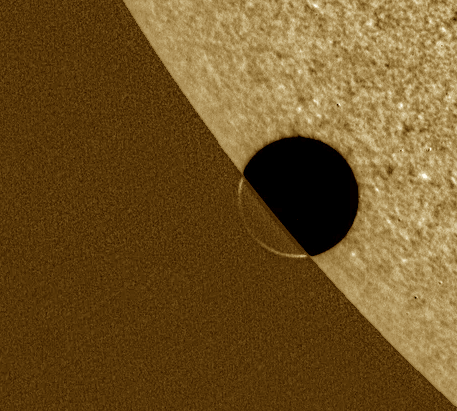
There's No Place Like Home... Well, Maybe
Phil Kesten
We recently wondered about the transit of planet across the face of its star; now let’s wonder a bit about the science behind the search for far-away planets.
Astronomers found the first evidence for a planet outside our solar system in 1992. The list of such “exoplanets” now numbers well over 2,000, with more than 1,300 of them found to be members of multiple planetary systems.
We have discovered planets relatively near Earth, and we’ve found some halfway across the galaxy. We know of one planet that orbits its star once every two hours (two hours!) and another that takes thousands of Earth years to go around once. We’ve found planets much smaller than Mercury and planets much larger than Jupiter. We’ve found planets on which the temperature is pleasantly similar to that on Earth and planets hotter than the surface of the Sun.
We live in an amazing universe.
We’ve learned most of what we now know about distant planets from watching as a planet passes across the face of the star it orbits. Even a relatively large planet passing across the face of a relatively small star, however, makes only the tiniest difference in the brightness of the star light we see. The fact that we can even just find exoplanets in this way is a triumph of science.
But these transits are the key not only to finding, but also studying, exoplanets.
We can, for example, determine the constituents of an exoplanet’s atmosphere when the planet passes between us and its star. Take a look at this image of Venus as it begins a transit across the face of the Sun:

Venus as it begins a transit across the face of the Sun
That little bit of fuzziness around the edge of the planetary disk is the atmosphere of Venus. Light from the sun that traverses the atmosphere before it reaches us gives clues about the composition of the atmosphere.
Imagine light passing through a glass of carrot juice, striking b-carotene molecules in the juice along the way. As light passes through carrot juice, blue and green light is absorbed because it makes the b-carotene molecules wiggle. The other colors of light – red, orange, and yellow – make it all the way through. So carrot juice looks orange, a clue to the presence of b-carotene.
In the same way, we can discover which molecules are present in the atmosphere of an exoplanet by measuring which colors of light it absorbs.
Is there water or oxygen in a planet’s atmosphere? That would be one indicator of a planet similar to the Earth. And also of the possibility that the planet could, perhaps, sustain life. An Earth “twin” should also be about the same size and mass as the Earth, and be in the “habitable zone,” that is, a distance from its star so that the planet’s surface temperature is neither too hot nor too cold.
Planets that orbit a star at a distance that provides conditions just right for life are sometimes said to be in the “Goldilocks zone.” The list of exoplanets known to be in this zone numbers in the 30s and is growing. Many are about the same size as the Earth. We are also finding more and more exoplanets that either have or likely have an atmosphere. And yes, we’ve already found oxygen and water in the some of those atmospheres.
There’s no guarantee, of course, that life exists (or existed) on the Earth-twin exoplanets we are discovering, but it sure makes you wonder. Who knows what might be crawling around, or walking around, on such a planet!
--------------------------------------------------------
Questions to ponder:
Are any of the exoplanets we’ve already discovered, any of the other billions of exoplanets, like the Earth? Could there be, or could there have been, intelligent life on any of them? And there is or had been intelligent life, how would your own view of the world, and of humans, change?
Jun 2, 2016

